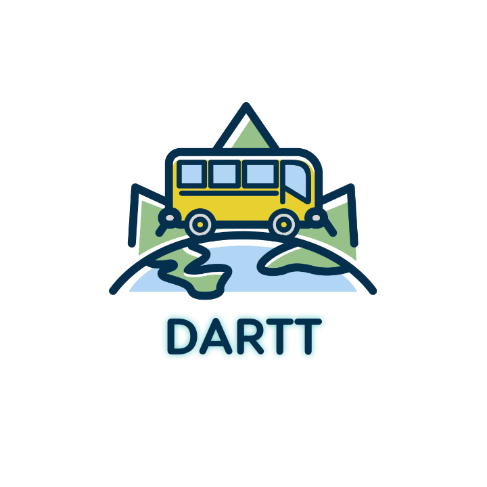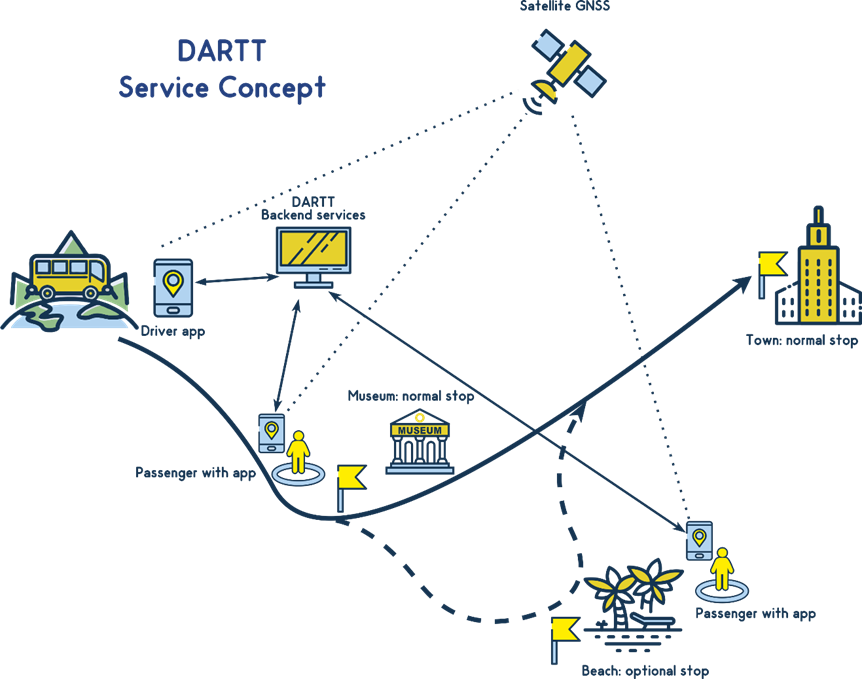
Objectives of the service
Public transport in rural areas of South - Eastern Europe suffers from low ridership and infrequent service. However, several of these areas are tourism-heavy that could greatly benefit from an expansion of services to different sites of touristic interest. However, there is significant risk for transport providers in expanding their networks in areas of uncertain demand.
DARTT aims to close this gap by providing a complete end-to-end solution for public transport providers to deploy on-demand transport services. Transport operators can then lower the risk of expanding their transport network, while offering passengers improved travelling experience. By offering a demand-responsive solution via our mobile apps, operators can create customized itineraries to additional bus stops only when they know that passengers exist for them.
Passengers can then benefit from enhanced accessibility of tourist sites via (otherwise not available) public transport, avoiding having to use more expensive means e.g., taxis or car rental. The DARTT passenger app also provides curated tourist information, offering a one-stop user-friendly experience addressing the difficulties usually encountered by tourists in using public transport in rural areas.
Users and their needs
DARTT targets Greece, as a characteristic pilot country, and the regional bus/coach companies of Greece (KTEL). These private entities operate regular bus services over specific areas. There are 62 rural & intercity companies of this type in the country. We initially focus on two KTELs as pilot customers.
The foremost driving customer need in the target market is their economic viability. This is especially true in rural areas, where bus companies have few passengers and operate with low profit. KTELs are also not seen as flexible as private vehicles by new users.
Potential DARTT users (passengers) can include residents and tourists visiting the area that wish to use public transport to reach a destination not regularly served by the KTEL. Tourists commonly face several difficulties in less touristically –developed rural areas when using public transport: language barrier, lack of e-booking website / timetable / route / pricing information, difficulty in finding related information e.g., which route for specific sites, out of date information, etc.
Other stakeholders also interested in DARTT can potentially include tourism-related stakeholders, e.g., hotel associations that wish to see the transport links of the area improved. These may not necessarily become direct customers but can help provide up-to-date local information.
Service/ system concept

DARTT will enable bus companies in rural areas to expand their coverage network and customer base by offering an innovative demand-responsive transport service. It will consist of:
- a mobile App to be used by passengers,
- a mobile App for the bus drivers, and
- a web app to administer the service
Tourists will be able use the passenger mobile app to discover local sites serviced by a region’s buses, getting information about them and the transport services offered. DARTT will both showcase a region’s lesser visited, yet interesting sites, and offer booking transport to reach them via scheduled or on-demand services. To ease the difficulties traditionally encountered in visiting areas outside the mainstream, DARTT will integrate touristic product presentation and comprehensive public transport services. This information which will be kept up to date by the bus company, with input from local tourism stakeholders to promote the area’s different sites.
The on-demand transport service will be feature optional stops which will only be serviced, dynamically, when tickets have been booked for them. The bus will then detour from its regular route to call there. To book these, the app will show the next available time that the bus can arrive there, taking into account the existing schedule, current vehicle & passenger location using GNSS, and any restrictions that the company may have set. When booking a ticket, the Mobile App will connect to the bus company’s payment system to collect payment. After the transaction is completed, the e-ticket will be stored in the passengers’ phone (e.g., using a QR code) so that it can be verified when they board the bus.
The driver mobile app will show the updated route that they have to follow in realtime, based on the on-demand bookings that have been made and can also be used to inform the demand-responsive component of expected times at stops.
The DARTT web application will support the mobile apps and will also be used by local tourism stakeholders (hotels, local government, etc) to enter information for the local sites of touristic interest.
Space Added Value
Satellite positioning is used by the DARTT driver mobile application to locate the buses in real time. This information is used by the DARTT backend services to decide the optimal scheduled service to amend with the additional on-demand stops.
Satellite navigation is also used to guide drivers once such a stop has been added to a route. The real time updating of the location can make routes more flexible, as the system can immediately be informed of any delays without manual driver intervention. This can improve services e.g., by the system not offering to sell tickets to destinations that would miss connections due to delays.
Satellite positioning/navigation is also used by the passenger mobile app to locate users so that they can find the bus stops, during their trip to show progress and announce the stop that they need to get off at, to navigate the ‘final mile’ (after they get off the bus to reach their destination) and used as trigger to provide contextual information about nearby sites or transport services. This will greatly reduce uncertainty of the travel experience and make it more accessible and pleasant for tourists in unfamiliar areas.
Current Status
The DARTT Kickstart activity has now completed.
- Questionnaires and a brief presentation of the project were sent to all potential customers, while interviews with the pilot customers were held. Interviews with regional and tourism stakeholders also took place.
- The service concept has been developed and improved based on customer and stakeholder input.
- The main value proposition has been validated by the pilot customers.
- The initial technical design, technology selection, and provisioning model of the service have been completed, and the service deemed technically feasible. A small Apple iOS app was created to demonstrate the way the product will be used to interested customers.
- The financial viability analysis has shown there is solid growth potential and positive revenue projections.
The Final Review was successfully completed with ESA in early June 2021.



